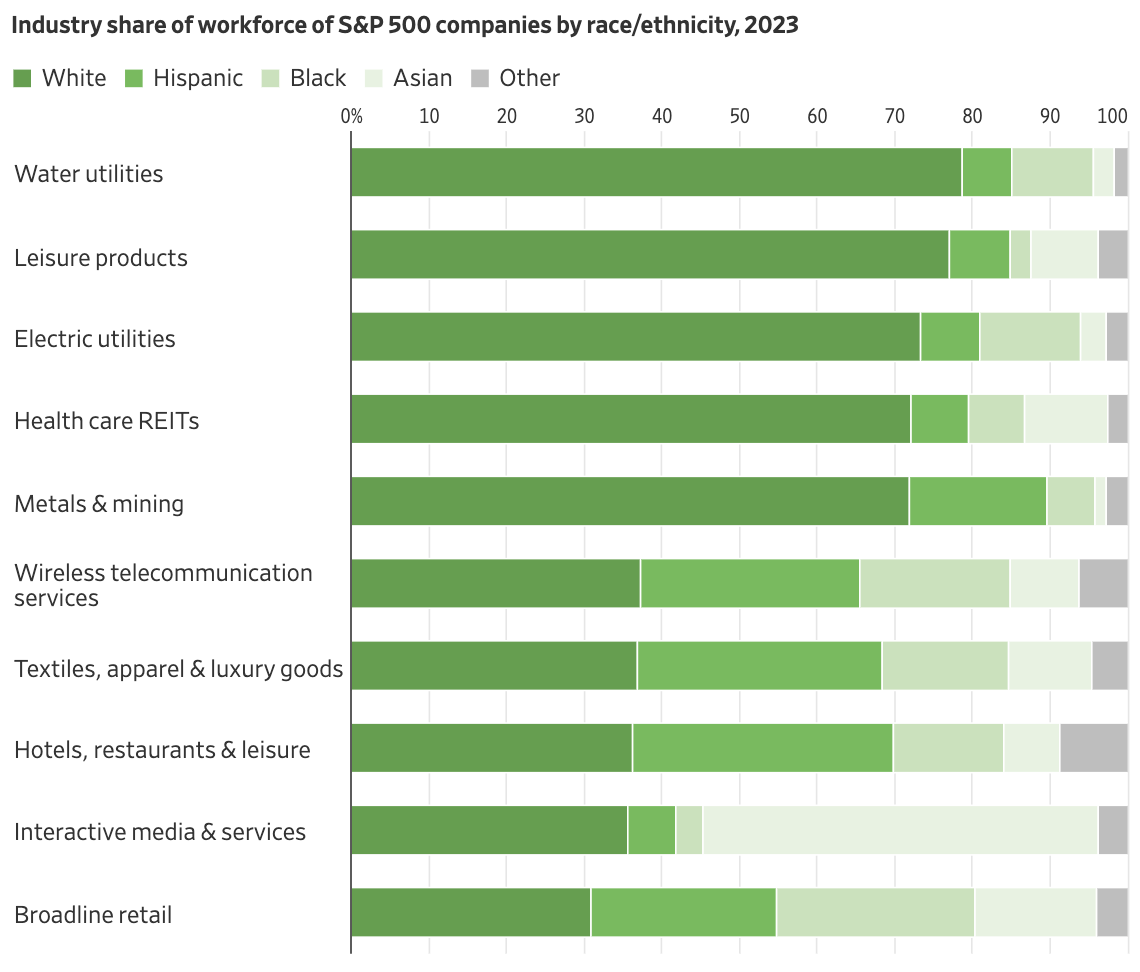Big companies are retreating from initiatives to diversify their workforces amid a legal and political backlash, and the Trump administration is rooting out such practices in the federal government. DEI opponents argue those initiatives and practices amount to reverse discrimination.
Yet such policies haven't radically changed who advances up the corporate ladder in the short time they have been in place, a Wall Street Journal analysis of 13 million workers at S&P 500 companies found.
Share of employees at S&P 500 companies by race or ethnicity and gender Sources: U.S. Labor Department and DiversIQ
After George Floyd's murder in 2020, businesses stepped up efforts to broaden the mix of workforces and leadership teams. These diversity, equity and inclusion-or DEI-practices can include various approaches, from ensuring candidates for jobs come from a variety of backgrounds to using executive pay incentives to increase representation of specific groups in specific roles.
In the four years since then, the workforces of the biggest public U.S. companies have become slightly less white, and Asian and Hispanic employees have made modest gains, according to 2023 data provided by research firm DiversIQ. The numbers are drawn from reports companies provide on their U.S. workers to the Equal Employment Opportunity Commission.
The picture is more lopsided in the upper ranks of these companies. White men have lost a little ground but still occupy half of all senior manager roles. White women-a bigger focus of corporate diversity efforts before 2020-have experienced the least change since then. The share of senior managers who aren't white, meanwhile, rose to 26% from 22%.
A closer look at specific job categories shows Black and Hispanic employees still make up a small fraction of executive and other higher-paid professional jobs. In 2023, one in 20 senior managers was Black-less than half the share of Black workers in the broader U.S. workforce. Hispanic managers make up a similar share, well below their numbers in the total labor force.
Most executives who aren't white are of Asian descent, as are most lower-level managers and professionals such as computer programmers and financial analysts. Meanwhile, Black and Hispanic workers together fill the majority of hourly service and manual-labor jobs.
The retail industry is the biggest employer of Black workers, in part because of Walmart and Amazon. Those companies employed about a quarter of all Black workers in the Journal's analysis of 250 companies. Hispanic staff hold more than a third of hospitality jobs, including at McDonald's and other fast-food chains and casino operators such as MGM Resorts.

Most diverse workforce
With hundreds of thousands of workers in warehouses and other logistical operations, Amazon has one of the most diverse workforces-though its senior management remains largely white. About 69% of its roughly one million workers were people of color in 2023, compared with nearly 67% in 2020.Amazon embarked on a pandemic hiring spree and made a push to hire more Black executives into high-level roles. Over four years, the share of nonwhite senior managers nearly doubled, with those of Asian descent rising the most. Black executives made up 5.5% of all senior managers, up from 3.6%.
In a memo to employees in December, the company said it was halting some of its DEI efforts, without specifying which, and focusing on programs with proven outcomes.
Executives and senior managers at Amazon by race and ethnicity, 2020 vs. 2023 No change Source: DiversIQ
Slashing goals
Deere, the world's largest seller of farm equipment, has one of the least diverse workforces in the analysis—more than 83% of its overall workforce was white in 2023. It was also one of the first companies to land in the crosshairs of anti-DEI activist Robby Starbuck last year. It soon announced it would dial back some of its diversity measures.Many job categories at the Moline, Ill.-based company did become more diverse since 2020, including senior-management roles. White men, though, still held 62% of the 224 executive and senior management roles and white women held another 19%.
Share of Deere workers who are nonwhite, 2020 vs. 2023 Note: Omits job categories with fewer than 50 workers Source: DiversIQ
The biggest change was among technicians, a job category with fewer than 800 workers. There, the share of people of color increased to 27%, up from 16% in 2020.
Gender divide
The balance of men and women in senior ranks also hasn't changed significantly at many companies. At Meta Platforms, about 36% of the company's executives and senior managers were female in 2023, almost unchanged from 2020.The company's overall workforce reflects a similar gender balance. While women made up a greater share of sales roles in 2023 than they did in 2020, they lost ground in lower-level management positions.
Share of Meta workers who are female, 2020 vs. 2023 Note: Meta didn't categorize any of its employees as operatives or laborers and helpers. Source: DiversIQ
At 51%, people of Asian descent made up the biggest share of Meta's U.S. workforce in 2023, up from 45% in 2020.
Meta said in January that it would roll back some of its diversity programs and that it would no longer dedicate a team to DEI.
Write to Inti Pacheco at inti.pacheco@wsj.com, Elizaveta Galkina at elizaveta.galkina@wsj.com and Theo Francis at theo.francis@wsj.com


